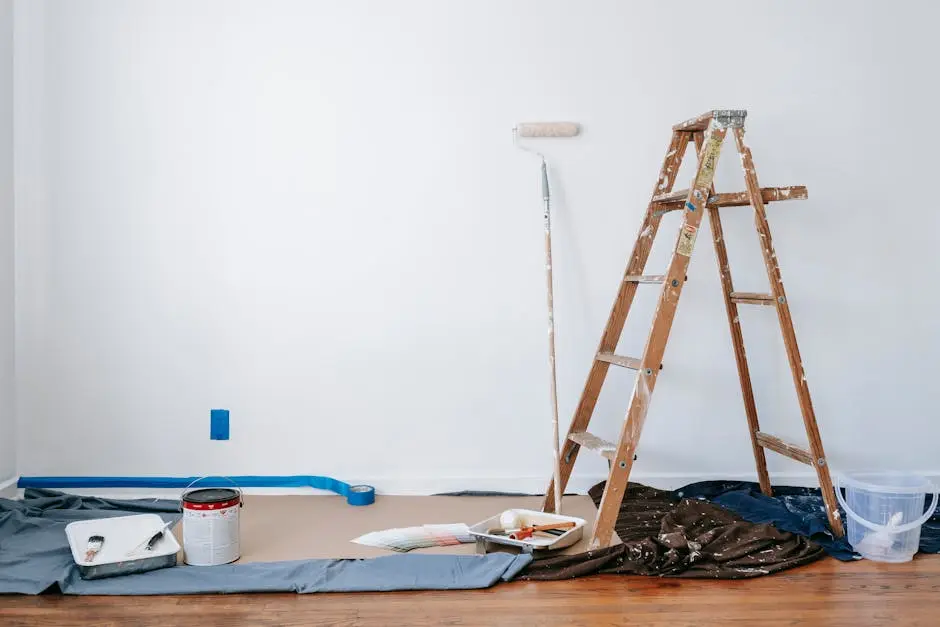Transforming your dining room with a fresh coat of paint can be a rewarding project. However, achieving that picture-perfect look involves more than just choosing a color you love. Avoiding common pitfalls can save time, money, and frustration, ensuring your dining room becomes a space you’re proud of.
1. Skipping Surface Preparation
Proper surface preparation is crucial for a smooth finish. Clean the walls, fill in any cracks or holes, and sand down rough areas before you start painting. This foundational step can significantly impact the final result. If you neglect these tasks, you risk the paint peeling or chipping prematurely. Additionally, starting with a clean surface minimizes the chances of dirt or debris ruining the paint work. A thorough cleaning with soap and water can remove oils and grime that might prevent paint adhesion, and using a putty knife to fill holes ensures no unsightly marks mar your fresh paint job.
The importance of sanding cannot be overstated. Even if your walls appear smooth, subtle textures can appear under a layer of paint. Sanding with medium-grit sandpaper evens out imperfections and sets the stage for a refined finish. Furthermore, taking a methodical approach ensures even overlooked corners receive attention. For those new to painting, consider investing time in researching effective surface preparation techniques, such as watching tutorials or consulting interior design experts.
2. Choosing the Wrong Paint Color
The color you love on a sample may look different on your walls. Consider the room’s lighting and test a few samples before committing to a shade. It’s wise to paint small sections of your walls with different hues to see how they interact with natural and artificial light. Observing these samples at different times of day provides valuable insight into each color’s variance. Some shades might appear warm in daylight but too stark or dull in the evening. Understanding the basics of color theory can also aid your selection process, ensuring your choice complements your dining room’s furniture and decor effortlessly.
3. Ignoring Paint Finishes
Different finishes suit different spaces. While matte finishes can hide imperfections, semi-gloss or satin finishes are easier to clean, crucial for dining rooms. A semi-gloss finish can add a subtle shimmer that enhances both modern and traditional settings. In contrast, a high-gloss finish can make an impressive statement but might be overwhelming for those unaccustomed to its sheen. Experimenting with finishes on sample boards can provide clarity before painting begins.
Choosing the right finish influences not just aesthetics but practicality as well. In a high-traffic area like a dining room, where spills and splatters are likely, a finish like satin offers durability and ease of maintenance. When cleaning up spills, it’s far easier with this type of finish, allowing for a quick wipe down without scrubbing away paint. Evaluating finishes involves not just current needs but future expectations, especially if using the space for vibrant gatherings or serene family dinners.
4. Not Using Primer
Primer helps paint adhere better and increases longevity. Don’t skip this step, especially when covering dark or glossy surfaces. Primers work as a preparatory coating, setting an optimal base that allows the paint to absorb uniformly. Without primer, expect potential blotchiness as different wall sections absorb paint at varying rates. Opting for a primer tailored to your specific wall conditions, perhaps a bonding primer for glossy surfaces, improves coverage while enhancing the paint’s color accuracy.
Primers are especially useful in dining rooms where color uniformity matters significantly. Whether you’re shifting from a bold to a neutral color or transitioning to a lighter shade, primer is indispensable. A standard white primer often suffices, but tinted primers exist for those moving from a starkly different wall color. This preemptive step saves paint and minimizes the issues of undertones bleeding through, leading to more radiant color displays. Explore various primer options that cater to unique requirements and embrace this small step as a big leap towards an impeccable finish.
5. Overlooking Lighting Conditions
Natural and artificial light can affect how a paint color looks. Be sure to consider these factors to avoid any surprises after you paint. Natural daylight tends to bring out the truest hue of your paint, while artificial lighting, especially incandescent bulbs, casts a warmer tone. Consider utilizing smart lighting solutions to adjust the warmth and brightness, tailoring them to showcase your wall colors at different times of the day.
6. Applying Uneven Coats
Uneven coats can ruin your dining room’s aesthetic. Apply even layers using proper techniques to ensure a smooth, uniform finish. This includes maintaining a consistent pressure and speed with your roller or brush. Overlapping your strokes slightly prevents thin patches and encourages an even spread of the paint. For beginners, using a quality roller that’s appropriate for the wall’s texture can significantly improve results. Watching video tutorials on painting techniques can offer helpful insights and improve skill proficiency.
Another secret to avoiding uneven coats is maintaining a wet edge as you paint. If you’re using water-based or latex paint, which dries relatively quickly, this technique prevents lap marks and ensures seamless color flow. Be strategic with the amount of paint used on your brush or roller to prevent overloading, which might lead to drips. Investing in angle-cut brushes allows easy access to tight corners, supporting a thorough and even painting process without missing edges or intricate details.












